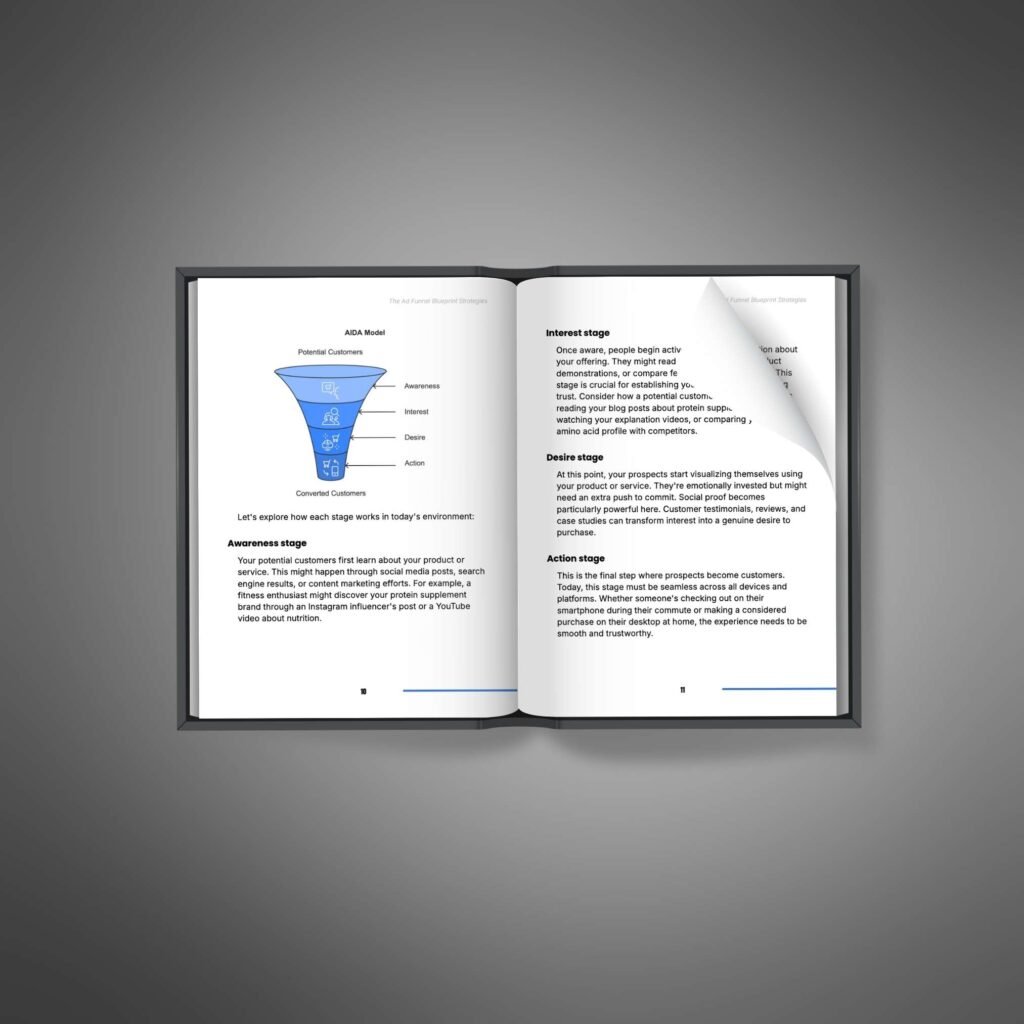Have you ever wondered why some ads effortlessly convert strangers into loyal customers, while others simply vanish into the digital ether? The reality is, most of your website visitors aren’t ready to buy immediately. In fact, research from Outbrain reveals that a staggering 96% of first-time website visitors aren’t prepared to make a purchase. This isn’t an ad failure, but a natural part of the customer journey.
In today’s noisy digital landscape, success isn’t just about grabbing attention; it’s about guiding that attention intelligently through proven ad funnel strategies.
Understanding the Psychology Behind Every Click: The Modern AIDA Model
Most marketers are familiar with the AIDA model: Awareness, Interest, Desire, and Action. While this traditional framework remains relevant, it has evolved significantly to match current consumer behavior patterns. Understanding and mastering the art of guiding potential customers through their buying journey — from awareness campaigns to conversion funnels — has become essential for business success.

Picture your ad funnel as a carefully crafted series of touchpoints. At each stage, your potential customers have different needs and expectations. Tailoring your message to these stages is crucial.
- 1. Awareness Stage: The First Spark. In this initial stage, your potential customers first learn about your product or service. This might happen through a viral social media post, a Google search result, or an engaging blog article. The goal here isn’t the sale, but intrigue. You need to capture their attention and make them curious about what you have to offer. Think about creating “thumb-stopping” visuals or headlines that instantly spark interest.
- Actionable Tip: Use visually impactful content and clear, benefit-focused headlines. For example, instead of “Our New Productivity App,” try “Transform chaos into clarity. Reclaim 2 hours every day for what truly matters.”
- 2. Interest Stage: The Information Hunt. Once aware, people begin actively seeking information about your offering. They might read blog posts, watch product demonstrations, or compare features with competitors. This stage is crucial for establishing your expertise and beginning to build trust.
- Actionable Tip: Offer interactive content, video tutorials, or detailed guides that address common questions and present your unique value proposition. For instance, if you’re selling protein supplements, your potential customers might spend hours reading your blog posts about protein supplementation or watching your explanation videos.
- 3. Desire Stage: The Emotional Connection. At this point, your prospects start visualizing themselves using your product or service. They’re emotionally invested but might need an extra push to commit. This is where social proof becomes particularly powerful. Customer testimonials, reviews, and case studies can transform interest into a genuine desire to purchase.
- Actionable Tip: Incorporate user reviews, comparison tools, and case studies that demonstrate real-world impact. Video testimonials, in particular, tend to considerably outperform text reviews in driving conversions due to their authenticity and emotional connection.
- 4. Action Stage: The Moment of Truth. This is the final step where prospects become customers. Today, this stage must be seamless across all devices and platforms. The checkout experience needs to be smooth and trustworthy.
- Actionable Tip: Simplify the checkout process. Research from WebFX demonstrates that reducing form fields from 11 to 4 can soar conversion rates by 120%. Also, transparency about all costs (especially shipping fees, which lead shopping cart abandonments ) and offering multiple payment methods are crucial for effective ad funnel strategies.
Beyond Theory: The Practical Roadmap for Your Marketing Funnel
The challenge isn’t just understanding these stages, but creating seamless transitions between them. This requires careful attention to content alignment, timing of message delivery, and true personalization. Your content should provide value at every stage of the journey, anticipating questions even before customers ask them.

While analytics tools can reveal what customers do, your expertise and empathy help you understand why they do it. This combination of quantitative and qualitative insights enables you to create truly effective customer journeys that drive business growth. Implementing robust ad funnel strategies involves blending data-driven insights with human understanding.
Ready to Master Every Stage of Your Ad Funnel?

This is just a small glimpse into the ad funnel strategies and insights you need to build an ad funnel that consistently converts. The world of digital marketing is dynamic, and sustained success comes from a deep understanding of your audience, careful planning, and continuous refinement based on real data.
To move beyond the basics and dive into actionable strategies proven over years of testing and optimization across various industries, you need a comprehensive blueprint.
Our ebook, “The Ad Funnel Blueprint Strategies: Attract, Engage & Convert Customers,” covers every crucial element of a successful ad funnel strategy: from selecting the right targeting options to crafting compelling ad copy, from building trust through content to optimizing for conversions. You’ll be equipped with the tools and insights to transform your advertising efforts, ensuring your business thrives in an increasingly competitive digital marketplace. Only 23% of marketers feel confident in their ability to extract meaningful insights from their data. With this ebook, you’ll join that confident group.
Don’t let your marketing budget go to waste on clicks that don’t convert.
Click here to get your copy today and start building ad funnels that deliver real results: https://vazcord.com/product/ad-funnel-blueprint-strategies-attract-engage-conver/


